Have you ever wished that a laser could tell you the weather? If you have, then [tuckershannon] has you covered. He’s created a machine that uses a laser and some UV sensitive paper to draw the temperature and a weather icon! And that’s not all! It’s connected to the internet, so it can also show the time and print out messages.
Building on [tuckershannon]’s previous work with glow-in-the-dark drawing, the brains inside this machine is a Raspberry Pi Zero. The laser itself is a 5mw, 405nm laser pointer with the button zip-tied down. Two 28BYJ-48 stepper motors are used to orient the laser, one for the rotation and another for the height angle. Each stepper motor is connected to a motor driver board and then wired directly to the Pi.
The base and arm that holds the laser were designed in SolidWorks and then 3d printed. The stepper motors are mounted perpendicular to one another and then the laser pointer mounted at the end. The batteries have been removed from the laser and the terminals are also wired directly to the raspberry pi. The Pi is then connected to Alexa via IFTTT so that it can be controlled by voice from anywhere.
The real beauty of [tucker]’s laser drawing machine is that is will draw out the temperature and weather icon, as well as drawing the time in either digital or analog forms! We’ve seen [tuckershannon]’s work before. The precursors to this project were his clock which uses a robotic arm with a UV LED on it to draw the time and another clock which uses similar robotic arm only with a laser attached. Let’s hope we get to see the rest of [tucker]’s progress!















I think a blue laser will get you the same florescence as a UV laser and you can ditch the safety glasses. at least I know it works on strontium aluminate.
Are blue lasers frequently more powerful than ratings like how green ones are? If so, you should probably keep those glasses on….
UV lasers are scary with or without glasses, so blue might be a bit better.
You may be able to use an SMD blue LED and a lens for a similar effect. Should be safer because it’s only focused at the screen plane. Might get blurry though.
-Or simply draw from behind? Florescent paper looks the same from back projection.
I can confirm. I bought months ago some lasers (pack of 3 sold on Ebay, red green and blue) then some luminescent glowing tape of different colors and tried the lasers on them: red and green lasers have no effect at all (or very very faint) on all tapes, while the blue laser lights them all, although the green one is by far the most visible.
Someone should measure the level of UV coming from those lasers; from the strange colors the targets assume I’d bet thy emit a lot of stuff beyond visible blue light.
As others have said, this is a blue-violet 405 nm laser, not UV.
The human eye is much less sensitive to 405 nm than 532 nm, so a 5 mW green laser might be uncomfortably bright, while a blue one of the same power appears dim.
There’s a gotcha: In the blue laser, what you see is all there is in the beam. But in a standard 532 nm DPSS (diode-pumped solid state) laser it’s a completely different story. That 532 nm light is produced by frequency doubling infrared 1064 nm light from a YAG laser, which is in turn pumped by a quite powerful 800 nm diode laser.
Those conversion processes from 800 nm to 1064 to 532 are not at all perfect. To get 5 mW of green out might require 100 mW of 800 nm pump power (from 700 mW of electrical input). Much of the quite powerful longer invisible wavelengths can make it through to the output. A reputable manufacturer will use quality mirrors and install an infrared-blocking filter to stop those longer wavelengths from escaping. A negligent manufacturer might use a lower quality mirror, or omit a filter entirely, letting a dangerous amount of invisible laser light out. I have measured a DPSS laser putting out 5 mW of green light, while also putting out a positively hazardous 30 mW in the infrared. (This laser I bought in 2008 from a presumably reputable street market vendor in Beijing :-) It still works.)
The fade would be great for radar on a limited area showing progress, or lightning strikes with their history intensity. Both would be displayed on a map of your area.
It’s not really a UV laser, it’s a 405nm (violet) laser, aka a Blu-Ray laser diode.
True UV lasers (frequency-tripled Nd solid state diode-pumped lasers at 355nm, or helium-cadmium lasers, or excimer lasers, depending on how extreme your UV needs to be) are far more expensive than commodity 405nm laser diodes.
We really need a catchy term to describe this sort of thing – I’ve been saving pages for a while now and it gets cumbersome referring to it as “UV laser phosphorescent painting” or whatever! Any thoughts?
https://hackaday.com/2018/03/22/arduino-clock-jots-down-the-time-in-uv/
https://hackaday.com/2018/04/05/persistence-of-phosphorescence-clock-displays-youtube-stats-too/
https://hackaday.com/2018/05/06/glow-in-the-dark-globe-on-a-spherical-screen/
https://hackaday.com/2018/06/23/laser-draws-weather-report/
https://hackaday.com/2017/08/29/spell-out-the-time-with-frickin-laser-beams/
https://hackaday.com/2011/01/18/phosphorescent-laser-painting/
https://hackaday.com/2016/06/02/hackaday-prize-entry-glow-in-the-dark-plotting/
https://hackaday.com/2015/12/01/uv-laser-projector-shines-with-glow-in-the-dark-vinyl/
The “Oh shiny!” display.
A CO2 variant which carves it into the sides of aluminum cans would be cool. Load them into a chute, they drop into a holder, get zapped, ejected, next…
Found it. Link on his Thingiverse.
https://www.amazon.com/Silhouette-America-Glow-Printable-Sticker/dp/B00YU7R3H2/ref=sr_1_2?ie=UTF8&qid=1529269001&sr=8-2&keywords=glow+in+the+dark+sheet&tag=tv-auto-20
Cool! this Could be used to Emulate The Turrician Game intro…
How susceptible is the paper to burn-in?
Is it preferable to offset each “report” a bit to avoid such issues?